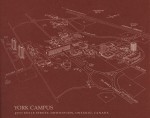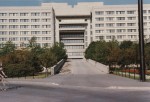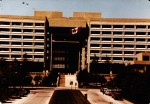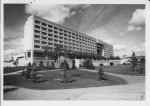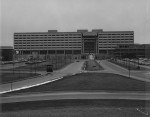A piece of the Ross Ramp
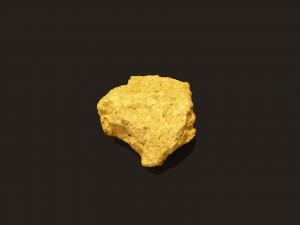
Donated as part of :
Most likely Murray Ross fonds, F0398
Context:
This is a piece of concrete saved after the destruction of the Ross Ramp which began in 1988.
The Ross Social Sciences and Humanities Building, opened in 1968 was designed as a grand entrance to the university.
According to Phillip Beelsey, the building was to be the key to the Keele campus, "its huge slab forming the edge of a pedestrian-oriented podium circled by a necklace of landscaped parking lots surrounded by farm fields." This enormous ramp was meant to emulate "a primordial temple front recast as an institution for the Age of Aquarius in the 1960s."
Designed by Gordon S. Adamson & Associates in partnership with John B. Parkin Associates and Shore and Moffat and Partners, the Ross ramp did not have the impact that its builders intended. Although it was meant to serve as the primary entrance to the university, the majority of pedestrians - be they students, staff or faculty- used the loading dock entrance located under the ramp to gain entrance to the Ross Building's offices and classrooms.
Former York President Harry Arthurs loathed the ramp (he called it "ugly, useless and totally misconceived") and endeavoured to destroy the 200 ft concrete monstrosity. He reminisced in a 2005 interview:
I’d just become president on Jan. 1, and this guy said, “You can’t use this space, this is the University’s prime entrance. You come up the ramp, you enter this space,” which was a big atrium on the north side of the Ross Building. So we’re up on the ninth floor, and I said, “Okay, it snowed last night. It’s now 11 o’clock, let’s go downstairs and see how many people came in, because we’ll be able to see the footprints.” There wasn’t a single footprint, it was utterly pristine.
In 1988, President Arthurs began a $1 million dollar renovation to tear down the ramp and grass over the parking lots. By 1991 the ramp has been replaced with the Vari Hall rotunda and the enclosed walkways that currently serve as the university's main entrance.
The Ross Ramp, despite its reputation, still holds strong memories for many York alumi. In 2009, members of YURA (York University Retirees Association) donated a number of items related to the ramp, including a pair of earrings made from smaller pieces of rubble by Karen Hecker. The late Nancy Accinelli in her recollection "From Shadows to Sunburn - the Days of the York Ramp" related how the focus of the campus was not the ascending steps but rather, 'Under the Ramp'. She elaborates:
Under the ramp you could find service vehicle parking, postal deliveries, pedestrian arrivals - a dark, shadowed driveway and doors providing the (real) main entry to the Ross Bldg for working drones as well as honoured dignitaries. President Cossiga of Italy? Under the ramp. President Mitterand of France? Under the ramp. Sniffing security dogs, lost students, seekers after gym shoes, library books, printing services, student services? All came in under the ramp.
Sources:
Ancinelli, Nancy.""From Shadows to Sunburn - the Days of the York Ramp" Donated as part of Reflections, Recollections and Reminiscences A project celebrating York's 50thAnniversary for the Clara Thomas Archives & Special Collections by the
Retirees of York University. Accession 2009-062.
Beelsey, Phillip. “Ross Social Sciences and Humanities Building, York University”. Concrete Toronto: a guidebook to concrete architecture from the fifties to the seventies. Eds. Michael McClelland, Graeme Stewart. Designer Steven Ho Yin Chong. Coach House Books and E.R.A. Architects, 2007.
Louise Brown. "York has 'come of age', says front-page story in the Toronto Star" Alumni Matters. (December 2004). Available at: http://www.yorku.ca/alumni/alumnimatters/dec-04/story2.html.
Woodward, Berton. "The Ramp Killer: YorkU Magazine. (October 2005 : 28-30). Available at: http://www.yorku.ca/web/about_yorku/yorku_magazine/YorkU_Oct05.pdf
"York honours long-serving staff." YFile. Tuesday December 5 2006. Available at: http://www.yorku.ca/yfile/archive/index.asp?Article=7543

